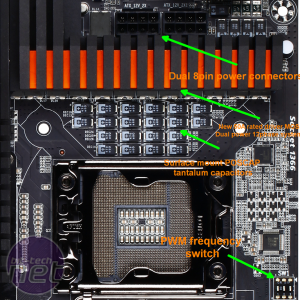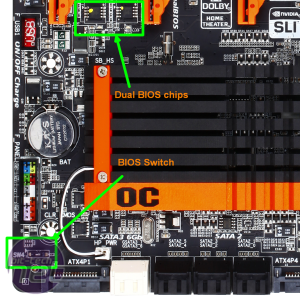
Gigabyte X58A-OC Preview
Manufacturer: GigabyteHere's a quick preview for you - we pulled these images of Gigabyte's new X58A-OC board off Hicookie's Facebook page earlier. Hicookie is Gigabyte's in-house extreme overclocker, and one of the principle designers of the board.
 The first feature you notice is the board's striking orange and black colour scheme. Gigabyte is still committed to the LGA1366 socket this year, and as the most famous extreme overclockers usually get their CPUs for free, you can expect plenty of Core i7-990Xs to fill the CPU socket. However, despite the high aspirations, the price will apparently be akin to the price of Gigabyte's current X58A-UD5, which is definitely affordable.
The first feature you notice is the board's striking orange and black colour scheme. Gigabyte is still committed to the LGA1366 socket this year, and as the most famous extreme overclockers usually get their CPUs for free, you can expect plenty of Core i7-990Xs to fill the CPU socket. However, despite the high aspirations, the price will apparently be akin to the price of Gigabyte's current X58A-UD5, which is definitely affordable.In the top left you can see that the rear I/O panel has been completely shrunk to its bare essentials. There are two USB 3 ports, two USB 2 ports, a Gigabit Ethernet connector, PS/2 keyboard and mouse ports (good if you want to completely disable USB, for example) and basic audio connectors.
Hicookie states that all the heatsinks light up orange - you can just see the small white power cables providing power for them. Meanwhile, you'll find an LED read-out and the OC Touch buttons in the top right hand corner. This OC Touch area homes the Power and Reset buttons, a '4G' instant 4GHz overclock button and the Gear button. The latter enables you to make adjustments to the CPU ratio and base clock on the fly, so you can boot at a lower speed, get the CPU warmed up and then pump up the base clock. There's a voltage checking area with sockets for multimeter GPIOs too.
The power hardware hasn't been detailed yet, but Gigabyte claims that each of the 12 power phases can push out 50A for a total of 600W. There should be a dual phase design too, but it's not yet known why, or whether it uses alternate sets of phases on each restart like the UD9.
Gigabyte claims that the two 8-pin PCI-E sockets above the CPU socket can support up to 720A or 1,500W, so really you only need to use one to provide the full 600W. However, using two could potentially lower the stress across both of them, and some PSU designs may use alternate 12V rails for each 8-pin connector.

MSI MPG Velox 100R Chassis Review
October 14 2021 | 15:04











Want to comment? Please log in.